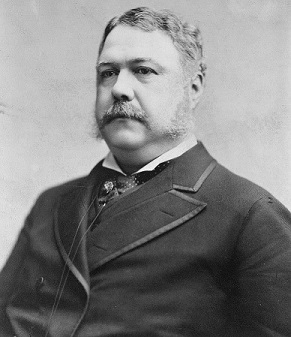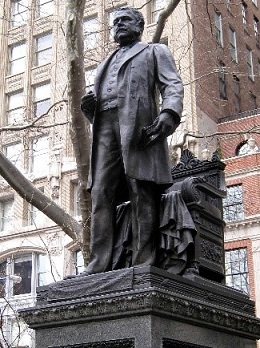Chester A. Arthur (1829 - 1886) [Section 24, Lot 8]
21st President of the United States, creator of the Civil Service Commission, Advocate for equal rights for blacks, “Father of the American Navy”

Chester Alan Arthur was born in Fairfield, Vermont on October 5, 1829, to Rev. William Arthur and Melvina Stone. He attended public schools in Union Village, present-day Greenwich, NY, and tutored by his father. Due to his family’s strong abolitionist views, it required them to move frequently due to unpopularity.
In 1844 they moved to Schenectady where Arthur enrolled at Union College, and to help pay his $28 a year tuition he taught school in a one room scholhouse on Ashdown Road in Ballston Lake. Though it has been noted that he was not a diligent student, Arthur graduated near the top of his class in 1848 at the age 18. From there he took a teaching job in North Pownal, VT and within three years he was principal of the academy. However, the pay was too little, ensuring Arthur’s continued part-time education in law in Ballston Spa.
By 1853 he was living in New York City working for U.S. Congressman Erastus D. Culver. Culver was a friend of the family and brought Arthur on to the law practice where he passed the bar exam in 1854, becoming a partner at the firm. Shortly thereafter Arthur became involved in two civil rights cases; the first was that he helped establish the precedent that any slave that arrived in New York was free, regardless of whether in transit or living in the state. The second case dealt with the desegregation of mass transit in Brooklyn, which eventually lead to desegregation in New York City as well.
Arthur became a member of the Whig Party one year before the party split on the issue of slavery. The anti-slavery portion of the party established themselves as Republicans, where Arthur became an early member and stayed one until his death. His stance on slavery led him to travel to Kansas and support anti-slavery forces only to return a few months later disgusted by the gratuitous amount of violence and lack of regard for law. He joined the state militia in 1857 and promoted to brigadier general, and engineer-in-chief.
In 1859 Arthur married Ellen “Nell” Lewis Herndon of Fredericksburg, VA with whom he had 3 children. Her father was Commander William Lewis Herndon, and namesake to Herndon, VA. When the Civil war started in 1861, Arthur found himself as quartermaster of the New York State militia, while also dealing with the fact that every member of his wife’s family was fighting on the Confederate side. He was relieved of his quartermaster post in 1863 having never accepted a bribe or gift and having ensured that every receipt and purchase was recorded for accountability.
Following the war, Arthur moved his family to New York City where he was appointed Collector in 1871 by President Grant, a position that he succeeded in due to his commitment to law and order. In 1878 he was fired from the position by President Rutherford B. Hayes in an attempted to minimize workforces and clean up the corrupt systems of government appointments. Arthur and his branch of the Republican Party felt shafted by Hayes’s actions and quickly began to organize, and successfully moved most of Hayes’s support from state positions.

In January of 1880 his wife died at the age of 42. Devastated of her death, he never remarried.
At the Republican National Convention later that year conflicts arose between the many factions of the party that saw 35 ballots done for the presidential ticket before a compromise was reached. James A. Garfield, a Half-Breed, was listed as president with Chester A. Arthur, a Stalwarts, as vice president. In accepting his nomination, Chester called for the “protection of Colored Citizens.” He had many goals, but all that changed after the election. The fact that he moved so many times in his youth came back to haunt him during the campaign as his opponents accused him of not being a natural-born citizen of the United States.
President Garfield was shot on July 2, 1881, but lived for another few weeks until September 19. The months in between were difficult as the U.S. Constitution made no statements on who had power while the President was incapacitated but alive. The additional issue of the assassin being a Stalwart supporter of Chester Arthur further complicated matters. Though Arthur was loved by the people, upon becoming president he fired Garfield’s Cabinet, and issues arose from appointments lead Republicans no to endorse him for reelection.

While serving as president his sister, Mary Arthur McElroy of Albany, served as the role of first lady in addition to raising his youngest child, Nell. At times she was joined by one of her daughters as hostess to dinners to foreign diplomats.
During Arthur’s presidency, he was able to help with a variety of policy issues and civil reforms such as aiding the Native Americans population through increased education. In 1883 he signed the Pendleton Civil Service Reform Act, which prohibited solicitation of federal employees for campaign contributions, something that had been a mandate for federal employees to retain their jobs. As a result, this policy change led to the establishment of the Civil Service Commission, with civil service qualifications for federal jobs. His passion for modernizing and expanding the U.S. Navy and the appropriation of fund for new steel cruisers gained him the nickname “Father of the American Navy.”
In May of 1883, President Arthur, along with NYS Governor Grover Cleveland, presided over the dedication ceremony of the Brooklyn Bridge, the largest suspension bridge ever built to date which connected the New York City, the largest city in the U.S. to Brooklyn, the third-largest.

Chester died on November 18, 1886 of a stroke caused by the effects of Bright’s Disease, a chronic inflammation of the kidneys. Initially diagnosed in 1881 it was kept secret until after he was out of office, in 1885. He is buried in his family plot alongside his wife, son, daughter, parents, and three sisters. The “Angel of Sorrow” stands within the family plot and is one of the most recognizable monuments within the cemetery. It cost $10,000 to construct, with a portion of the funds donated by school children while the rest came from “Friends of President Arthur.” The Friends also commissioned the construction of a statue of Arthur in New York City’s Madison Square Park.
In 2005, The Presidential $1 Coin Act intended to “revitalize the design of United States coins” and went into circulation in starting in 2007 in the order that they served as president. Due to minting errors, costs associated with minting, and threat of potential unlawful reproduction, the programs was suspended in 2011. A limited quantities were produced for collectors starting with President Arthur in 2012 and continued until 2016 with President Reagan.